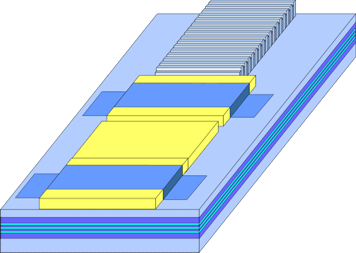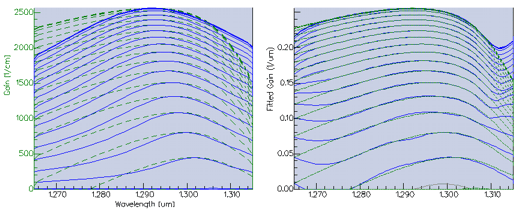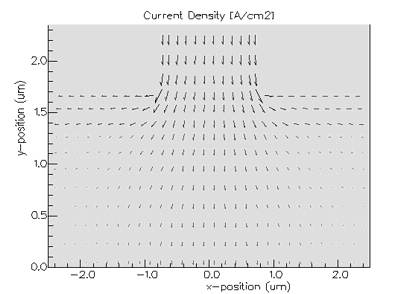|
Introduction
Features
‣
Active Module
‣
Electrical model
‣
Laser Geometries
‣
Analysis
‣
Building Block System
‣
Link to
FIMMPROP
‣
Link to Harold
‣
Link to EPIPPROP
‣
Scripting / Optimisation
Applications
Options
Design
Kits
Publications
Download
Brochure
Request evaluation
|
Active Module
The Active Module provides a detailed physical model allowing the simulation of various types of
amplifiers (SOAs) and lasers, as well as
modulators and photo-detectors. This permits also a large range of laser diode
types, including Fabry Perot, DFB, tuneable and ring lasers.

Physical Model
The
active model includes the
following physics:
Dynamic SOA/laser gain and spontaneous emission spectra as function of carrier density and temperature - using
data imported from Harold
or other sources
-
Dynamic QCSE-EAM absorption/refractive index spectrum as function of bias voltage and temperature - using
data imported from Harold
or other sources

Green lines are gain spectra of an InGaAsP-InP QW material for increasing carrier density.
(Left) Blue lines – a parabolic gain fit to the green lines, (right) blue lines – PICWave’s
Wide-Band Gain Fitting
showing an accurate model over a much wider spectral range, making PICWave ideal for SOA applications.
Lorentzian optical phase and intensity noise model Lateral current spreading/leakage in cladding
-
Multiple contacts on active sections

Current density vector plot showing lateral current spreading in a ridge waveguide laser
Carrier diffusion Electrical noise model Travelling wave electrode model Longitudinal hole burning Lateral hole burning Non-linear gain suppression/spectral hole-burning model based on intraband relaxation time
-
Multiple carrier levels with defined interband transition times, allows modelling of e.g. carrier capture-escape between bulk and QWs, or SCH carrier transport time

PICWave can model the interaction between multiple carrier levels. Here PICWave separately
tracks the carrier population in the quantum wells and in the bulk of an InGaAsP laser, taking the
capture/escape dynamics into account. This effect causes strong damping of the modulation
response of the laser as shown in the graph.
Auger processes Thermal effects
-
MQWs
-
Dynamic chirp (due to changes in carrier density)
-
Doping effects on mobility, refractive index and
absorption
-
Extensive analysis
of the results
Applications
Comparison between PICWave and Harold
Please see here for a
comparison of the active component (laser diode, SOA, modulators etc.)
modelling capabilities of PICWave,
Harold,
Harold XY and
Harold QCSE.
|











